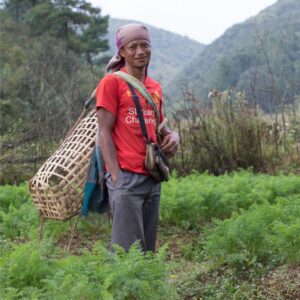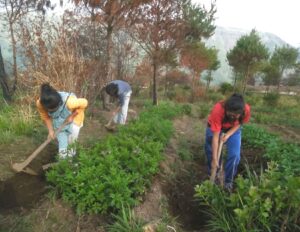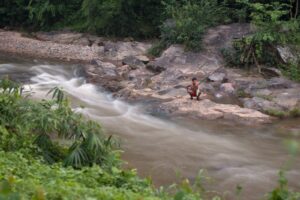Agriculture, without doubt, is the most important sector of the economy of Meghalaya. It contributes to more than 20% of the State GDP and provides employment to more than half of the labour force in the State. Therefore, it wasn’t a surprise when during his visit to Songsak in East Garo Hills the Chief Minister, Conrad Sangma, declared that his government prioritizes the farming community. Of course, he is not the first and won’t be the last to make such a statement. Words are judged by the actions that precede them. In this matter, there seems to be some gap.
A couple of months ago it was reported that less than 9000 farmers, which constitutes around 1% or less of the State’s farming population, got the benefits of the PM-KISAN scheme. This particular scheme of the Union Government of India was very important considering the severity of the Covid-19 second wave that hit the country earlier this year. Unlike the first wave, this time around, the virus was able to penetrate the rural hinterland. Now more than ever was the time to support the farming community. The meager number of farmers from Meghalaya who were able to avail the benefits points to the fact that this did not happen.

To be fair, it must acknowledge that the entire blame cannot be laid on the door steps of the current government. The low number of beneficiaries is the outcome of the systemic changes that have been at work since the colonial period. These changes are characterised by the ongoing process of privatisation of the commons, i.e., ‘Ri Raid’ or ‘A’king’ land, which has created the phenomenon of landlessness in the State; more than 70% of the population of Meghalaya are landless. The link between landlessness and the low number of beneficiaries is brought out by the eligibility criteria fixed for availing the PM-KISAN scheme.
In the Frequently Asked Questions section of the PM-KISAN website, question number 6 is regarding the eligibility of the beneficiaries: Who is eligible to get benefits under the PM-KISAN scheme? The answer was “all landholding families, which have cultivable land holding in their names, are eligible to get the benefit under the Scheme”. On the other hand, the Socio-Economic and Caste Census of 2011 had already brought to light the fact that almost 60% of the rural households do not own any land. The criterion, thus, was a sly move to remove the need to support this substantial section of the rural population reducing the financial expenditure of the Government. This tactic worked only too well in the case of Meghalaya with not even 2% of the farmers getting the benefit in 2021. The blame was laid on the inability of the beneficiaries in providing ‘correct and verified data’. That, of course, is an excuse and reveals more the ineptitude of the administration in checking the veracity of the documents rather than the people who provided the information. But even if correct data is provided, the number of farmers who would have potentially got the benefit is very small. This can be verified by looking at last year’s figure of those who got the benefit under the PM-KISAN scheme.
The story published in the Financial Express by Rajeev Kumar on February 20, 2020 revealed that in 2020, 78,331 farmers from Meghalaya applied for the scheme. The number of farmers who got the benefit was 70,236. It is difficult to imagine that the more than 70,000 farmers who were able to correctly submit their documents and get the benefit last year have somehow been left out this time around. The number of beneficiaries should have gone up, not down. This is nothing but an excuse by the Government to cover up its own ineptitude. At the same time, even if the same number of beneficiaries from last year were to get the benefits, that number is just around 10% of the farmers in the State. Majority of the farmers will still miss out. Being landless they are not eligible for the Scheme.
Something which has to be considered in the case of North East India in general and Meghalaya in particular is the land tenure system. In many cases, individual rights to land are subsumed under community rights. Not having land does not mean not having access to land. The community allocates land to the residents for farming. Therefore it stands to reason that landlessness in the way how it is perceived in the mainstream society does not exist. Landlessness does not exist because the concept of private property does not exist. This might be a compelling argument if private land holdings are non-existent or limited within the local community. Data and personal experience proves otherwise.
The Socio-Economic and Caste Census of 2011 has also reported that more than 34% of the rural household population in Meghalaya derives the major part of their income from manual casual labour. This population for sure is landless. Such a conclusion is supported by experience. On December, 2021, NESFAS organised a workshop on Soil and Seeds in the village of Umsawwar (located in the Mawkynrew Block of East Khasi Hills). Farmers from different parts of the State took part in the program. In the workshop, discussions were held with the farmers regarding the ways to improve soil fertility. Prevention of soil erosion through terrace constructions was discussed as a possible solution. Some of the farmers cited their inability to implement the solution because they were farming on rented lands. Since they did not own the land, they cannot make any permanent improvements on it whose benefit they may only enjoy in the long term. For those who live a hand-to-mouth existence, short term gains which means the daily struggle of not going hungry takes precedence. In the Mawkynrew area itself, entire villages do not have any agricultural land of their own. They instead rent it from the neighbouring villages. In a story published in the Times of India on the 13th July 2015, Subodh Ghidiyal had emphatically stated that landlessness as revealed by the Socio-Economic and Caste Census of 2011 is the key to rural deprivation in the country. The same holds true for Meghalaya as well.
If the Conrad Sangma government is really serious about its commitment to the farmers it needs to take the issue of landlessness seriously. Till date this does not seem to be the case. In the same program where the Chief Minister made the statement, he informed the audience that the State Government is looking to set up more PRIME hub centres (akin to the Songsak PRIME hub) across the State. These centres, according to the PRIME Meghalaya website, are centres for innovation, knowledge sharing, incubation and skill development. In short, the answer to rural distress is entrepreneurship. While the solution has merit, without reforming the background on which any such solution will function, i.e., the existing land tenure pattern characterised by high degree of landlessness, the chances of its success is highly truncated. Political concerns in Meghalaya have mostly been about identity which in its most basic form is linked to land. However, concerns of land per se have remained subsidiary. If landlessness is not tackled it will become the most important issue of the future, if it is not already so.
This article was also published in The Shillong Times



